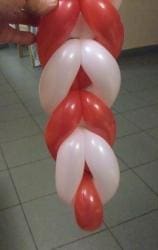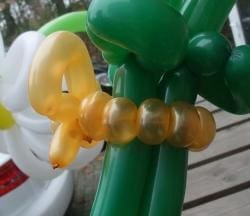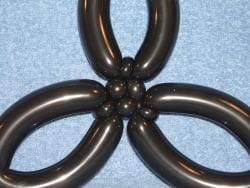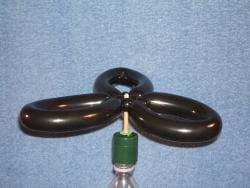Creativity Abounds
by Ralph Dewey
I have conducted several Twister Think Tanks (TTT) and all of them have worked out very well. The first one was in Houston, the second one was at the Diamond Jam convention in Phoenix and the third one was at the Millennium Jam in Belgium. I have plans to conduct more of them. So what exactly is a Twister Think Tank? It is a gathering of top twisters who share new twister ideas with the group. It is a round table forum for creative twisters. Only twelve top twisters are invited to the event so that the group isn’t too large. Why only twelve twisters? In a small group people are less intimidated and feel more at ease to speak freely. A small group allows a measure of intimacy. A small group size facilitates the asking of questions or the offering of suggestions about the balloon ideas presented. The group interaction and synergy helps to develop even more new ideas. What kinds of ideas are shared at the TTT? Primarily new techniques or balloon designs are shared. But balloon magic, balloon stage performance ideas and balloon resources are shared as well. Other ideas could be about tip jars, balloon carts, adhesives, line-ending methods, sources for special balloon shapes or new ideas for keeping balloons organized. In other words, ideas that twisters could use. Each TTT participant is asked to bring their own original ideas to the table. Two ideas or fairly new ideas are the minimum. However, sometimes the other participants are inspired by what they see during the event and they are reminded of additional ideas that they can share. So instead of 24 ideas being shared, there could be more like 30 or 40 new ideas getting shared. By having creative twisters learn the latest ideas, they can incorporate them into new and better ways to make balloon creations. So the ultimate purpose of the Twister Think Tank is to elevate the art of balloon sculpturing. One rumor has it that the TTT is some sort of a secret club or society. That’s not true. After the event, all of the ideas can be shared with every twister. Only once did one of the participants ask that their idea not be divulged until it could be used in a balloon competition. And I think that was a reasonable request of the group. I will be asking some other top twisters to participate in future Twister Think Tanks. Have you got a couple of new ideas that you want to share?
More New Creative Balloon Ideas
New balloon techniques are necessary in order for new creative balloon ideas to be developed. New techniques open the door for new shapes, new looks and new possibilities. Below are a few new balloon ideas that I’ve learned.
In the past I have used the castration banding pliers (Elastrator) to insert objects into balloons. They are available in the USA at the Tractor Supply Company for about $18.00. Pascal Grooten showed me a new way to use the pliers and the rubber o-rings to make spider legs and other cool things. Not only do they make an interesting design, but the o-rings give the spider legs (or whatever they are used for) some physical support. Pascal showed me using orange o-rings and recently I’ve found some dark green ones. I’m hoping to find other colors too.


See the headband that I made using a red #260 and dark green o-rings.

While at the Millennium Jam, I saw an interesting balloon decoration. It was invented by Fredic Holterhoff. He placed a colored balloon at the nipple end of clear #646 balloon. Several of these were arranged in a star cluster.

I saw an interesting new weave that Sofie Vandewyer was using for her balloon competition piece. I don’t know what it is called, but it looks like a wheat weave to me. It takes four #160 or #260 balloons and is fairly easy to do. I’m tinkering with some new designs that use it.

Antonio Becares Rodriquez shared with me his “Pinch Line Twist” technique. Notice that the series of bubbles have a square-like shape instead of being round. They are not round bubbles and they are not ear twists, something in between.

I found a Christmas ornament motor a few weeks ago. It uses a small battery so it will work to power the blades of a balloon helicopter. The device is called the OrnaMotor II Rotating ornament motor and sells for about $8.00. It is made by Roman, Inc. in Addison, Illinois, USA. I attached a 1/4″ wooden dowel to the shaft and then slipped the center of the balloon propeller over the dowel. Notice that the center of the propeller has three bubbles. This is similar to how a drill chuck works. It gives your propeller a center pointer



Recently I bought a battery-operated hamster. Most toy stores have them right now. Mine was made by the ABL Innovation Co. in China and cost about $8.00. I placed it in a clear round 3-foot balloon (about 1/3 inflated) and turned it on. Since only one of the wheels is powered, it kept wanting to go around in a circle. See my YouTube video to see what it did.
It might make an interesting effect for your stage show.